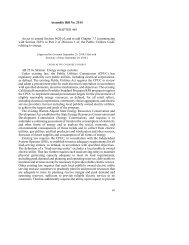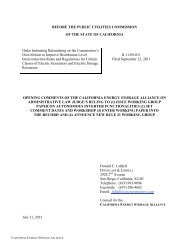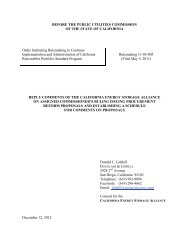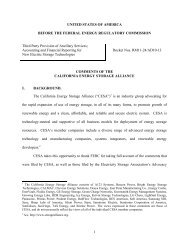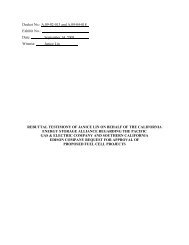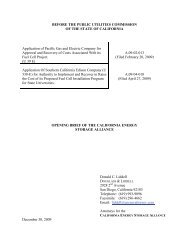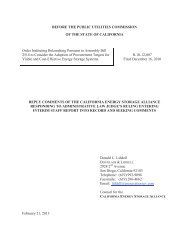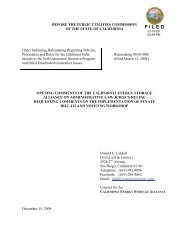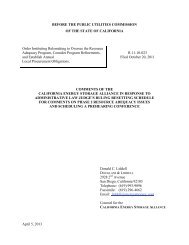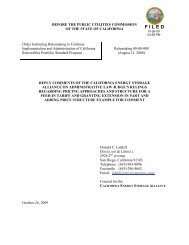Reply Comments - California Energy Storage Alliance
Reply Comments - California Energy Storage Alliance
Reply Comments - California Energy Storage Alliance
You also want an ePaper? Increase the reach of your titles
YUMPU automatically turns print PDFs into web optimized ePapers that Google loves.
BEFORE THE PUBLIC UTILITIES COMMISSIONOF THE STATE OF CALIFORNIAApplication of Pacific Gas and ElectricCompany (U 39-E) for Approval of DemandResponse Programs, Pilots and Budgets for2012-2014.Application 11-03-001(Filed March 1, 2011)Application of San Diego Gas & ElectricCompany (U902M) for Approval ofDemand Response Programs and Budgetsfor Years 2012-2014.Application 11-03-002(Filed March 1, 2011)Application of Southern <strong>California</strong> EdisonCompany (U338E) for Approval ofDemand Response Programs, Activitiesand Budgets for 2012-2014.Application 11-03-003(Filed March 1, 2011)REPLY COMMENTS OF THE CALIFORNIA ENERGY STORAGE ALLIANCE TOPROPOSED DECISION OF ADMINISTRATIVE LAW JUDGE HYMES ADOPTINGDEMAND RESPONSE ACTIVITIES AND BUDGETS FOR 2012 THROUGH 2014November 22, 2011Donald C. LiddellDOUGLASS & LIDDELL2928 2 nd AvenueSan Diego, <strong>California</strong> 92103Telephone: (619) 993-9096Facsimile: (619) 296-4662Email: liddell@energyattorney.comCounsel for theCALIFORNIA ENERGY STORAGE ALLIANCE
TABLE OF CONTENTSI. INTRODUCTION. ..............................................................................................................1II.III.IV.THE COMMISSION SHOULD ADDRESS ANY PERCEIVED DEFICIENCIES INTHE PLS COST-EFFECTIVENESS METHODOLOGY AND DR REPORTINGTEMPLATE IN THE ORDERED WORKSHOPS. ............................................................2THE COMMISSION SHOULD REJECT SCE’S RECOMMENDATION THATTHE UTILITIES SHOULD FILE THE ORDERED JOINT PLS PROPOSAL ONLYAFTER THE COMMISSION RESOLVES DEFICIENCIES IN THE DRREPORTING TEMPLATE. ................................................................................................3THE COMMISSION SHOULD REJECT PG&E’S REQUEST THAT THEPROPOSED DECISION BE MODIFIED TO STATE THAT INCENTIVESAPPROVED IN THIS PROCEEDING ARE COMPARABLE TO ANDSUPERSEDE THE INCENTIVES FOR ADVANCED ENERGY STORAGE INTHE SELF GENERATION INCENTIVE PROGRAM......................................................4V. CONCLUSION....................................................................................................................5
Proposed Decision identified in CESA’s Opening <strong>Comments</strong> as written. 2Only Southern<strong>California</strong> Edison Company, (“SCE”) and Pacific Gas & Electric Company (“PG&E”) raised anyissues in their opening comments that warrant a specific response by CESA. 3 The ProposedDecision’s bottom line conclusions for PLS are that “PLS programs are cost-effective. Wefurther conclude that investing in utility programs to encourage adoption of customer-ownedPLS resources is good policy as described in the EAP and set by <strong>California</strong> Public Utilities CodeSection 454.5(b)(9)(C).” (Proposed Decision, p. 144).It is noteworthy that none of the three utilities, SCE, PG&E, and SDG&E (“Utilities”),suggest in their respective opening comments that the Commission should question theircontinued commitment to the PLS program proposals already included in their respectiveApplications. CESA applauds the measured approach taken in the Proposed Decision to requirethe Utilities to (i) submit a joint revised PLS proposal consistent with the Proposed Decision’sconclusions, and (ii) follow up with a workshop to discuss any issues related to the joint revisedPLS proposal.II.THE COMMISSION SHOULD ADDRESS ANY PERCEIVED DEFICIENCIES INTHE PLS COST-EFFECTIVENESS METHODOLOGY AND DR REPORTINGTEMPLATE IN THE ORDERED WORKSHOPS.In their comments, SCE and PG&E raise a number of questions and concerns regardingthe PLS cost-effectiveness methodology and the DR Reporting Template that should beaddressed in future workshops. CESA need not, and does not, take sides in the debate betweenthe views of the <strong>Energy</strong> Division reflected in the Proposed Decision and those of SCE andPG&E reflected in their opening comments. Instead, CESA welcomes the opportunity to addressspecific PLS-related questions concerning cost-effectiveness methodology and program design2 See, Opening <strong>Comments</strong> of the <strong>California</strong> <strong>Energy</strong> <strong>Storage</strong> <strong>Alliance</strong> to Proposed Decision of Administrative LawJudge Hymes Adopting Demand Response Activities and Budgets for 2012 through 2014, filed November 17, 2011.3 CESA notes that San Diego Gas & Electric Company (“SDG&E”), which is equally subject to the directionprovided in the Proposed Decision, expressed no concern at all with the Proposed’ Decisions analysis or conclusionsrelated to PLS in its comments.2
issues, including the DR Reporting Template, once the ordered joint utility PLS proposal can beconsidered by the parties and discussed in the ordered workshops.III.THE COMMISSION SHOULD REJECT SCE’S RECOMMENDATION THATTHE UTILITIES SHOULD FILE THE ORDERED JOINT PLS PROPOSALONLY AFTER THE COMMISSION RESOLVES DEFICIENCIES IN THE DRREPORTING TEMPLATE.SCE apparently takes issue with the statement in the Proposed Decision that “. . . weconsider PLS to be different from other DR programs because PLS shifts energy usage on apermanent basis instead of merely decreasing energy usage during certain times. Because of thisdifference, we find it necessary and reasonable to review PLS and its cost effectiveness analysesdifferently from the other DR programs.” (Proposed Decision, p. 141).Rather than address each of SCE’s points here, CESA urges the Commission toencourage SCE, and the Utilities, to:“Work collaboratively to develop and propose a standardized, statewidePermanent Load Shifting program as described in this decision. The Utilitiesshall jointly submit the proposal as described in this decision to the <strong>Energy</strong>Division within 60 days following the issuance of this decision.” (ProposedDecision, Ordering Paragraph Number 49).If the Utilities proceed in good faith as directed, a consensus on all issues should be forged in theprocess of developing the ordered joint proposal. However, the Proposed Decision anticipatesthat it may not and addresses that possible outcome in the form of a workshop:“<strong>Energy</strong> Division shall hold a workshop to seek feedback from interestedparties and facilitate a consensus process for Pacific Gas and ElectricCompany, San Diego Gas & Electric Company, and Southern <strong>California</strong>Edison Company (the Utilities) to finalize their Permanent Load Shifting(PLS) statewide program design and rules.” (Proposed Decision OrderingParagraph Number 50).3
IV.THE COMMISSION SHOULD REJECT PG&E’S REQUEST THAT THEPROPOSED DECISION BE MODIFIED TO STATE THAT INCENTIVESAPPROVED IN THIS PROCEEDING ARE COMPARABLE TO ANDSUPERSEDE THE INCENTIVES FOR ADVANCED ENERGY STORAGE INTHE SELF GENERATION INCENTIVE PROGRAM.Regarding the Self Generation Incentive Program (“SGIP”), PG&E suggests that, “ . . . itmakes no sense to simultaneously start up and seek approval of two separate storage incentiveprograms – one in SGIP and one in DR. The PD’s enhanced budget is more than adequate for allstorage incentives and there is no reason to deplete SGIP funds otherwise available to othertechnologies.” 4CESA respectfully disagrees with PG&E for several important reasons:• First, the Proposed Decision explicitly excludes emerging technologies from the PLSprogram. Thus, the incentive levels that are anticipated under the PLS program are likely to bemuch lower than those available in the SGIP, which would automatically exclude many forms ofadvanced energy storage from the SGIP.• Second, the PLS program is intended to be technology neutral .As such, PLS can beprovided by a variety of means - not just energy storage. The Proposed Decision makes the pointthat battery storage and thermal energy storage are simply examples of PLS, at page 138, asfollows: “. . . it would be misleading to imply that the PLS program is ‘just for energy storage’and further, contrary to the spirit of the program for the Commission to pre-specify whichtechnologies are eligible.”• Third, maintaining technology neutrality will help ensure that a wide range of potentialtechnical solutions are possible in PLS programs, and will encourage greater competition which -over time - will help reduce cost and improve cost-effectiveness for ratepayers in both the PLSprogram and the SGIP.4 Pacific Gas and Electric Company’s Opening <strong>Comments</strong> on the Proposed Decision of Administrative Law JudgeHymes, filed November 17, p. 21.4
• Finally, the SGIP is demonstrably not a program purely intended for energy storageeither. SGIP incentives are available for a wide range of different non-storage (distributedgeneration) technologies on a first-come, first-served basis. It is simply not necessary to prespecifyspecific technology types for either program given that robust rules already exist in theSGIP that prevents any applicant from participating in another program simultaneously. Forexample, Section 6.12 of the 2011 SGIP Handbook specifically states: “For Projects receivingself-generating incentives under other programs, the SGIP incentive may be reduced, dependingon the source of the other incentive, effectively allowing only part of the other program incentivein addition to the SGIP incentive.” (2011 SGIP Handbook, p. 30).V. CONCLUSION.CESA thanks the Commission for this opportunity to reply to comments filed by theparties, and looks forward to continuing to work with the Commission and the parties to thisproceedingRespectfully submitted,November 22, 2011Donald C. LiddellDOUGLASS & LIDDELLEmail: liddell@energyattorney.comCounsel for theCALIFORNIA ENERGY STORAGE ALLIANCE5



